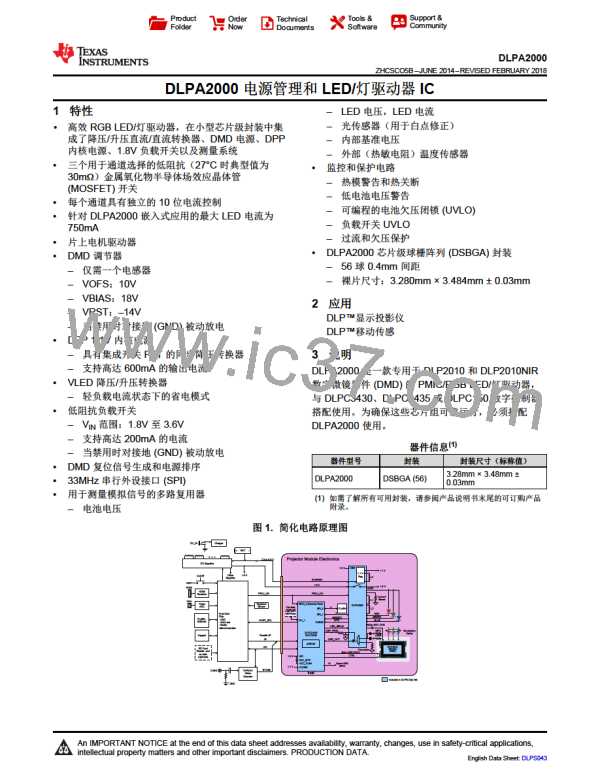DLPA2000
www.ti.com.cn
ZHCSCO5B –JUNE 2014–REVISED FEBRUARY 2018
8 Application and Implementation
NOTE
Information in the following applications sections is not part of the TI component
specification, and TI does not warrant its accuracy or completeness. TI’s customers are
responsible for determining suitability of components for their purposes. Customers should
validate and test their design implementation to confirm system functionality.
8.1 Application Information
A DLPC343x controller can be used with a DLP2010 (0.2 WVGA) DMD or DLP3010 (0.3 720p) DMD to provide a
compact, reliable, high-efficiency display solution for many different video display applications. The DMDs are
spatial light modulators which reflect incoming light from an illumination source to one of two directions with the
primary direction being into collection optics within a projection lens. The projection lens sends the light to the
destination needed for the application. Each application is derived primarily from the optical architecture of the
system and the format of the pixel data being input into the DLPC343x.
In display applications using the DLP2010 DMD or DLP3010 DMD, the DLPA2000 provides all needed analog
functions including the analog power supplies and the RGB LED driver to provide a robust and efficient display
solution. Display applications of interest include pico-projectors embedded in display devices like smart phones,
tablets, cameras, and camcorders. Other applications include wearable (near-eye) displays, battery-powered
mobile accessories, interactive displays, low latency gaming displays, and digital signage.
Alternately, a DLPC150 controller can be used with a DLP2010 or DLP2010NIR DMD. Applications of interest
when using the DLPC150 controller include machine vision systems, spectrometers, skin analysis, medical
systems, material identification, chemical sensing, infrared projection, and compressive sensing. In a
spectroscopy application the DLPC150 controller and DLP2010NIR DMD are often combined with a single
element detector to replace expensive InGaAs array-based detector designs. In this application the DMD acts as
a wavelength selector reflecting specific wavelengths of light into the single point detector.
8.2 Typical Projector Application
A common application when using DLPA2000 with DLP2010 DMD and DLPC3430 controller is for creating a
pico-projector embedded in a handheld product. For example, a pico-projector may be embedded in a smart
phone, a tablet, a camera, or camcorder. The DLPC3430 in the pico-projector embedded module typically
receives images from a host processor within the product as shown in Figure 42. DLPA2000 provides power
supply sequencing and controls the LED currents as required by the application.
DC_IN
Charger
BAT
2.3 to 5.5 V
Projector Module Electronics
DC Supplies
1.8 V
VSPI
1.1 V
1.8 V
1.1 V
Reg
1.8 V
Other
Supplies
On/Off
L3
SYSPWR
1.8 V
VDD
HDMI
VLED
HDMI
Receiver
PROJ_ON
PROJ_ON
Current
Sense
L1
L2
VGA
GPIO_8 (Normal Park)
Triple
ADC
Keystone
Sensor
DLPA2000
Cal data
(optional)
4
SPI_0
SPI_1
FLASH
4
Front-End
Chip
- OSD
- AutoLock
- Scaler
EEPROM
RED
GREEN
BLUE
RESETZ
INTZ
FLASH,
SDRAM
I2C_1
HOST_IRQ
PARKZ
BIAS, RST, OFS
3
LED_SEL(2)
CMP_PWM
-MicroController
WPC
Illumination
Optics
DLPC3430/
Keypad
DLPC3435
Parallel I/F
28
LABB
CMP_OUT
eDRAM
DLP2010
WVGA
DDR DMD
DMD)
I2C
SD Card
Reader, and
so forth
(WVGA
Thermistor
Sub-LVDS DATA
CTRL
1.8 V
1.1 V
VIO
(optional)
VCC_INTF
VCC_FLSH
VCORE
18
Spare R/W
GPIO
BT.656
CVBS
TVP5151
Video
Decoder
Included in DLP® Chip Set
GND
Figure 42. Typical Embedded Setup Using DLPA2000
Copyright © 2014–2018, Texas Instruments Incorporated
41

 TI [ TEXAS INSTRUMENTS ]
TI [ TEXAS INSTRUMENTS ]